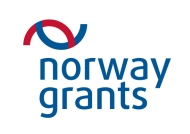Study sites
The Białowieża/Biełavieskaja Pušča Forest, a prominent example of transboundary NPA, located in between Poland and Belarus is one of the largest near-natural lowland forest of the European continent and the natural model of how primeval woodland ecosystems of Europe once looked like and functioned.
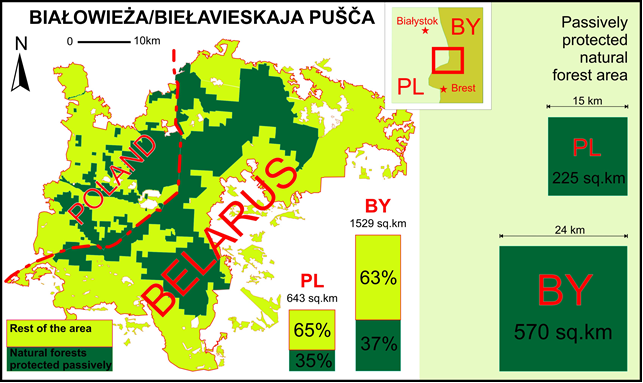
Megafauna like the wisent and wild horse, but also wild boar, red deer and elk, live in the forest. The whole area is about 2000 sq.km, about 2/3 on the Belarusian side, but not all the area is designated as national park. Covered by legal protection since Middle Ages, being the first National Park established in Poland in the XX century, the Białowieża forest is also a model case of attempts to long-term forest ecosystems conservation. However, this is linked to complicated relationships between wildlife and biodiversity conservation on the one hand and economic development on the other. Artificial division of the contiguous forest complex into two national segments after the World War II also adds to the site-specific conservation problems and challenges. Whilst the Polish segment of the forest has been a subject of intense empirical economic studies, this is absolutely not the case for its Belarusian segment or for the whole site as transboundary NPAs.
What distinguishes the Białowieża/Biełavieskaja Pušča/Biełavieskaja Pušča Forest from all other forests in Poland, Belarus and Europe is a high degree of naturalness preserved in a relatively large area. About one-third of the total area of the Białowieża/Biełavieskaja Pušča/Biełavieskaja Pušča Forest has never been logged, both on the Polish and Belarusian side. What it means is that in these places the wildlife is untouched by the human, this part of the Forest is covered in natural forest. It is currently subject to passive protection, both on the Polish side (35% of the Polish side of the Forest) and on the Belarusian side (37% of the Belarusian side of the Forest). The other fragments of the Forest, currently neighbouring with passive protection zones, are forests that have been used for production purposes in the last 100 years. The intensity of the production was not spatially homogenous and it has changed over this period. The entire area of the Białowieża/Biełavieskaja Pušča/Biełavieskaja Pušča Forest remained untouched until 1915. It was the place of traditional hunting by Ruthenian and Lithuanian princes, Polish kings and later by Tsars, so logging was prohibited. Later, in particular in the interwar period, the Białowieża/Biełavieskaja Pušča/Biełavieskaja Pušča Forest was intensely used. According to estimates, in those times trees were cut down from one-third of the Forest area. At the beginning of the 1990s the intensity of the forest management was reduced, when the existing passive protection zones were extended and the quantity of timber produced in the other area was decreased. As a result, the forests in Białowieża/Biełavieskaja Pušča/Biełavieskaja Pušča are currently diverse as regards the naturalness degree.
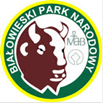 Białowieski National Park (PL)
Białowieski National Park (PL)  NP Biełavieskaja Pušča (BY)
NP Biełavieskaja Pušča (BY)
Historically, the human pressure on nature has been lower in the boreal/mountainous areas of Central/Northern Scandinavia, where several national parks have been established in the last decades. Fulufjället/Fulufjellet is a transboundary national park between Sweden and Norway, with 385 sq.km designated on the Swedish side in 2002 and 82.5 sq.km on the Norwegian side in 2012.
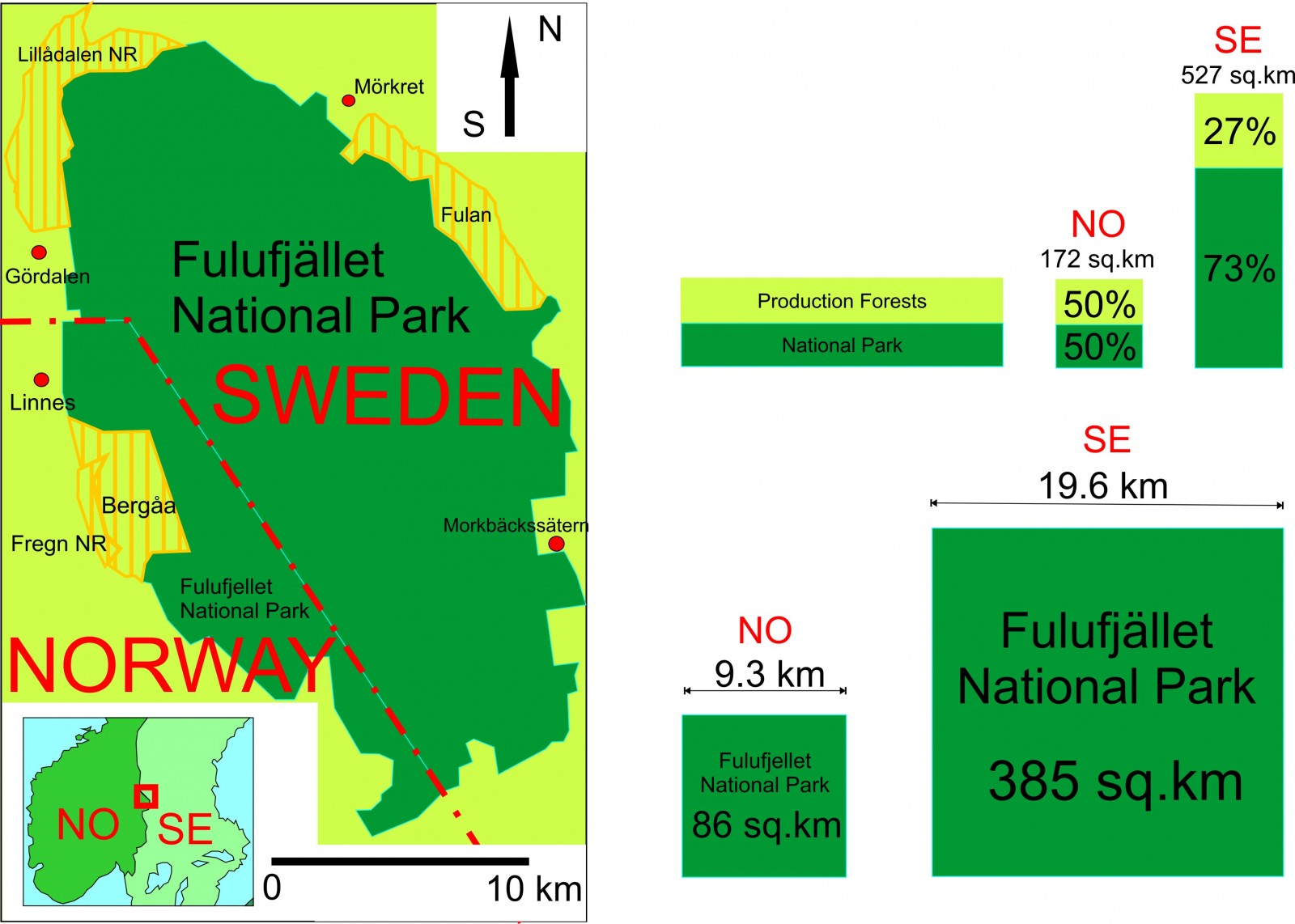
The park area consists primarily of a low alpine region, with large areas of thick lichen and some forest cover and scattered trees (including a Norway spruce tree, with an estimated 9550 year old root system, making it the World’s oldest living individual clonal tree). The forests in Fulufjellet are located primarily on the peripheries of the plateau, on the steep slopes and in some of the cirques. Megafauna is present in this park, like elk, hibernating bears, and beavers; and also wolves, wolverines, lynx, mink and otters might be observed, as well as nesting Gyr Falcons. Related to the national park designation on the Swedish side was a zonal differentiation of human activity: 1) a wilderness zone; 2) a low-intensity activity zone; 3) a high-intensity activity zone; and 4) a development zone. The latter zone includes the major park entrance with car parking, cafeteria and a visitor centre, and trails to the waterfall.
The new transboundary aspect of the park has not been investigated yet. As the institutional system is more similar between the EU country Sweden and the non-member Norway, relative to Poland and Belarus, the transboundary nature management might also be less challenging; possibly also impacting on the extent of strategic response behaviour. Although the scarcity of these types of nature areas is acknowledged through the protection statuses, various elements might impact on the continued preservation. Tourism might contribute to both support for the preservation and activity that might constitute pressure and disturbance. National park tourism is currently very important at the Swedish side of Fulufjället, and might potentially be enhanced at the Norwegian side. Assessments of human activity that can support or undermine the preserved nature can be addressed in survey questions following up on the choice experiment.
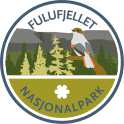 Fulufjellet National Park (NO)
Fulufjellet National Park (NO)  Fulufjället National Park (SE)
Fulufjället National Park (SE)
 Białowieski National Park (PL)
Białowieski National Park (PL)  NP Biełavieskaja Pušča (BY)
NP Biełavieskaja Pušča (BY) Fulufjellet National Park (NO)
Fulufjellet National Park (NO)  Fulufjället National Park (SE)
Fulufjället National Park (SE)


















